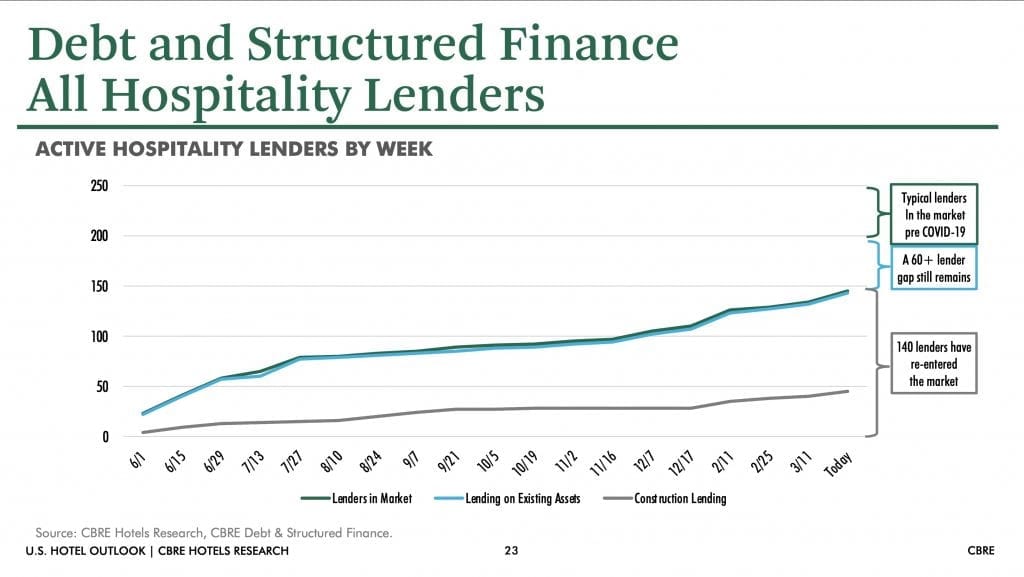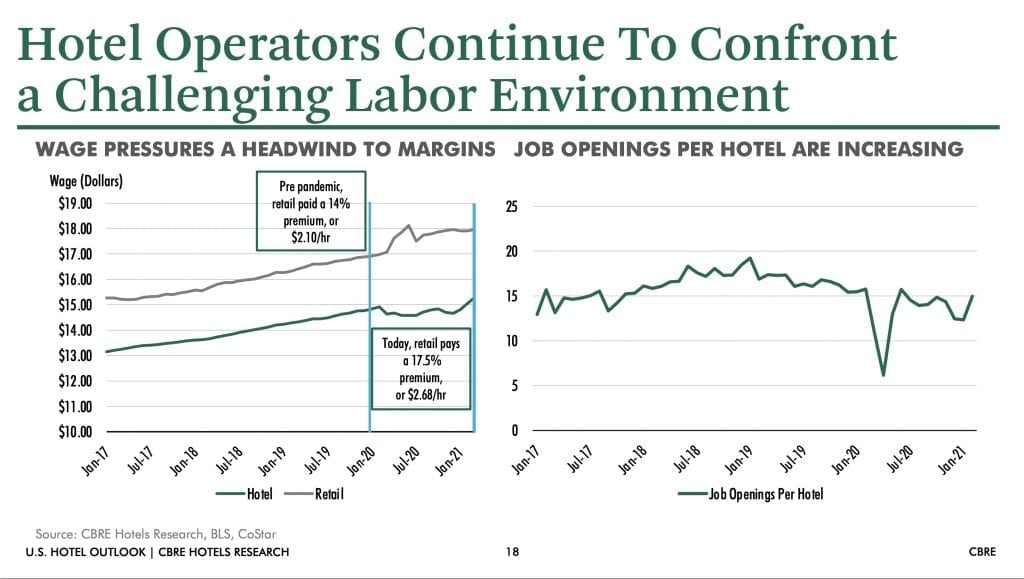Hotel Lenders Rush Back In Even With Growing Labor Shortage Crisis

Skift Take
U.S. hotels are a hot investor commodity despite the industry’s surging problem of not enough workers heading into the summer travel season.
While daily rates, revenue, and property values are all likely to return to pre-pandemic levels — and even eclipse them — the hotel industry’s labor market faces permanent changes. Other industries like retail offer more competitive wages to hotel workers with easily transferrable skills.
But investors don’t seem to mind that swelling operational issue. There’s only about a 60-lender gap between today’s market and the pre-pandemic one in the U.S., according to CBRE’s "U.S. Hotels State of the Union" report.
“The expedited return of capital to the market is faster than what we’ve seen historically,” said Mark Owens, head of hospitality capital markets at CBRE Hotels. “This is a far better return of liquidity to the market than we've seen historically for hotels, so that bodes really well for all of us.”
There was more of a lag following the Sept. 11 terrorist attacks and the Great Financial Crisis, despite those events having less of an impact on profitability and occupancy.

Lenders quickly returned to the hotel market following a sharp drop early in the pandemic (Credit: CBRE)
Given their willingness to take on more risk than a traditional bank, debt fund investors were the quickest to return to the market following pandemic pullbacks. A bank, which usually has better financing terms, will typically lend as much as 60 percent of the value of a real estate asset while debt funds will sometimes go as high as 75 percent.
Organizations like Bainbridge DXS and Torrey Pines Hotel Group as well as CGI Merchant Group are among the many to launch hotel investment funds during the pandemic.
But life insurance companies remaining in the hotel lending space is another financial anomaly to this downturn, Owens said. These investors, typically conservative with capital, took as long as 24 months to return to the hotel industry in prior cycles. If they went away at all during the pandemic, it was only for a matter of weeks.
The only type of investor that continues to lag are commercial mortgage-backed securities, a group of mortgages pooled as one that hotel developers use to build new projects. Nearly a quarter of hotel CMBS loans were at least 30 days delinquent last summer, but that figure steadily declined to 16 percent, as of late March.
“All of the different lender types, with the exception of CMBS, really came back relatively quickly,” Owens said. “And that just helps the engine of transaction activity work.”
The investors returning to the hotel market still tend to favor existing properties rather than new construction, partially because of the soaring costs of building materials.
Steel prices jumped nearly 18 percent just last month while lumber — used on typically more affordable-to-build midscale and extended-stay hotels — was up more than 6 percent, according to the U.S. Bureau of Labor Statistics.
That puts a major price swing between the planning stages and construction on projects that can take as much as 36 months to build. Developers still in the pre-planning process may decide to hold off on construction to see if prices calm down in the next two years.
“Costs are increasing substantially,” said Rachael Rothman, head of hotel research and data analytics for CBRE Hotels. “You have to wonder whether or not deals that initially penciled out 18 months ago are going to pencil out today.”
A Labor Crisis That May Never Go Away
Despite the pandemic putting hundreds of thousands of hotel employees out of work due to low occupancies, the industry is facing a massive labor shortage. U.S. hotels are about 600,000 employees off pre-pandemic levels, according to the U.S. Labor Department. But the industry is expected to have one of its busiest — if not the busiest — summers ever.
Some industry analysts rationalize the labor crisis is driven by the extra $300 in federal unemployment benefits put in place from the $1.9 trillion pandemic relief measure passed earlier this year. The extra funding, in place through early Septmeber, gives people less incentive to return to work, the thinking goes. But Rothman sees other factors at play.
“Maybe it is something to do with unemployment, but I think it's the general market dynamic as well,” she added. “You've had occupancy come back so much faster than people thought because of the vaccines.”
Occupancy rates that jump 30 percent in a matter of weeks have managers scrambling to call workers back, but those former employees may not be there to pick up the phone. Many retail outlets like grocery stores continued to hire during the pandemic, and they often pay better than hotels.

Better wages in industries like retail could lead some frontline hotel workers to permanently leave the industry. (Credit: CBRE)
The retail industry has a 17.5 percent, or $2.68 per hour, wage premium for frontline workers to hotels, according to the CBRE report. This was even a problem before the pandemic, when retail had a 14 percent wage premium over hotels.
Retail shifts can also be shorter and more flexible than hotels, which has a “strict demand pattern” around check-in and check-out. That puts pressure on hotel owners to increase wages in order to remain competitive among fellow hoteliers and different industries.
“Owners and brands and operators should be prepared for above-inflation increases in labor [costs], just as they were seeing prior to the pandemic,” Rothman said.




